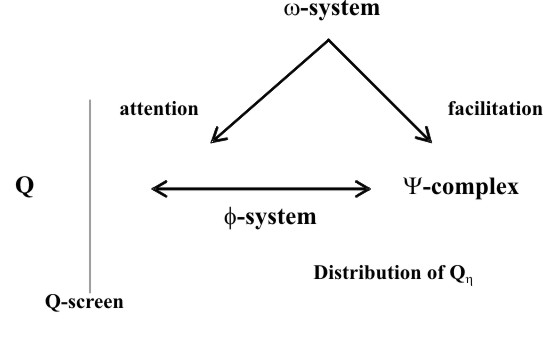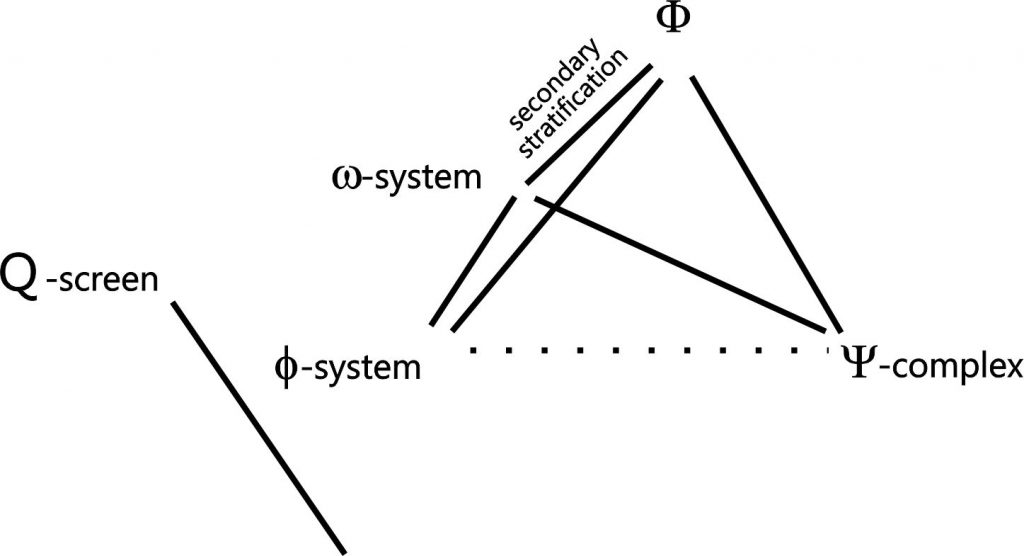Fundamental to the Project is the notion of Q – energy within the system. Between Q and Q in the external world are Q-screens, which are impermeable to Q. Two kinds of contact-barrier are then hypothesised: those which are permeable (), offering no resistance to the passage of Q; and those which are impermeable (), and therefore capable of holding back the passage of Q. Facilitation is then defined as altering of the thresholds of permeability of these contact barriers. I can represent this as follows:
 The -system is that which is reached by exogenous stimulation and through which the discharge of Q takes place; and the -complex is that which is reached by endogenous excitation. “-complex” because this is a system of complexification of distribution of Q across contact-barriers with varying thresholds of facilitation. The Pleasure Principle argues that the distribution of Q across this -complex follows a principle of constancy, through the facilitation of distribution and discharge via
The -system is that which is reached by exogenous stimulation and through which the discharge of Q takes place; and the -complex is that which is reached by endogenous excitation. “-complex” because this is a system of complexification of distribution of Q across contact-barriers with varying thresholds of facilitation. The Pleasure Principle argues that the distribution of Q across this -complex follows a principle of constancy, through the facilitation of distribution and discharge via
this model, Freud then adds an -system which conducts the periodicity of stimulation[1] arising at the Q-screen back to the -complex as a path of facilitation:
 Thus, on the one hand there are memory traces – specific configurations of -complexification; and on the other there are (let us say) complex waveforms which are the periodic correlates of these memory traces. This distinction between and is later read onto the distinction between thing-presentation and word-presentation, insofar as the latter is taken as being an indication of quality.[2] They are entangled with each other, however, in the sense that each implies the presence of the other, even if a particular pattern of -complexification is only a memory trace and cannot be repeated.
Thus, on the one hand there are memory traces – specific configurations of -complexification; and on the other there are (let us say) complex waveforms which are the periodic correlates of these memory traces. This distinction between and is later read onto the distinction between thing-presentation and word-presentation, insofar as the latter is taken as being an indication of quality.[2] They are entangled with each other, however, in the sense that each implies the presence of the other, even if a particular pattern of -complexification is only a memory trace and cannot be repeated.
Stratification
In his letter to Fleiss of the 6th December 1896, Freud postulated a process of stratification in which W [Wahrnehmungen (perceptions)] are neurones in which perceptions originate , to which consciousness attaches, but which in themselves retain no trace of what has happened; Wz [Wahrnehmungszeichen (indication of perception)] is the first registration of perceptions, arranged according to associations by simultaneity (; Ub [Unbewusstsein (unconsciousness)] is the second registration arranged according to the process of complexification ); and Vb [Vorbewusstsein (preconsciousness)] the third transcription, attached to word-presentation.[3]
What am I to ‘do’ with this third transcription? Freud comments that “the cathexes proceeding from this Vb become conscious according to certain rules; and this secondary thought consciousness is subsequent in time and is probably linked to the hallucinatory activation of word presentations, so that the neurones of consciousness would once again be perceptual neurones and in themselves without memory”. Just as perception leads through indication of perception to produce facilitating effects on the -complex, so the “subsequent in time” would indicate that the preconsciousness leads back through the system to produce effects of attention – a kind of echo. The important point here, however, is that whereas thing-presentations remain anchored in the -complex, the -system acts as a support for word-presentations, and ultimately for consciousness.
This whole system therefore acts as a kind of complex recursive structure which itself acts as a substrate to consciousness…. I want to propose a secondary stratification (the one described by Freud being taken as primary) by invoking the Lacanian reading of the project and introducing the effects of as the particular orienting of the subject’s relation to the lack of the Unconscious through the effects of the signifier. Introducing raises the whole issue of transference, the drive functioning and objet petit a, to which I will return in order to address the discourses. This secondary stratification can be understood as organisations of the -system itself becoming the support for ‘higher’ systems of signification.[4]
This produces the following further step in the topologising of the Project:

The dotted line is there because the -system does not affect the -complex in ways which are not mediated by the -system. There is no direct relationship possible, therefore, between and . The secondary stratification takes place on the other axis of to .
Why this topology? Because it is the structure of the ‘quadripod’ which Lacan describes in Savoir (p57-58 – Feb 3rd 1972 Seminar) and which determines the “fundamental topology from which any function of speech derives”. I tke this further in considering the structure of a Lacanian ‘discourse’.
Notes
[1] ‘Periodicity’ here refers to the “period of an excitation”: “I can see only one way of escape: to revise our basic hypothesis on the passage of quantity. Hitherto I have regarded it only as a transference of quantity from one neurone to another. It must have another attribute, however—of a temporal character; for the mechanics of the physicists have assigned this temporal attribute even to the motions of masses in the external world. I shall describe this attribute briefly as “period”. Thus I shall assume that the resistance of the contact-barriers applies only to the transference of quantity, but that the period of neuronic motion is transmitted without inhibition in every direction, as though it were a process of induction.” Project for a Scientific Psychology (1950 [1895]) Vol 1 Standard Edition. Page 310
Freud goes on to identify quality as the fundamental basis of consciousness: “Much remains to be done here in the way of physical clarification, for here as elsewhere the general laws of motion must apply without contradiction. But my hypothesis goes further, and asserts that the perceptual neurones are incapable of receiving quantities, but that they assimilate the period of an excitation and that this condition of theirs of being affected by a period, while being filled with only a minimum of quantity, is the fundamental basis of consciousness. The -neurones, too, have of course their period, but this is devoid of quality, or, to put it more accurately, is monotonous. Deviations from this specific psychical period reach consciousness as qualities.” Project for a Scientific Psychology (1950 [1895]) Vol 1 Standard Edition. Page 310. This will later form the basis for linking the acoustic word presentation with its ‘internal’ perceptual quality. Jokes and their relation to the Unconscious Vol VIII Standard Edition p119.
[2] See Appendix C of ‘The Unconscious’ Vol XIV Standard Edition pp209-215. Of particular interest in the Editor’s Preface is Freud’s equating of ‘object-presentation’ with the complex made up of the combined ‘word-presentation’ and ‘thing-presentation’: “The final section of Freud’s paper on ‘The Unconscious’ seems to have roots in his early monograph on aphasia (1891b). It may be of interest, therefore, to reproduce here a passage from that work which, though not particularly easy to follow in itself, nevertheless throws light on the assumptions that underlay some of Freud’s later views. The passage has the further incidental interest of presenting Freud in the very unusual position of talking in the technical language of the ‘academic’ psychology of the later nineteenth century. The passage here quoted follows after a train of destructive and constructive anatomical and physiological argument which has led Freud to a hypothetical scheme of neurological functioning which he describes as the ‘speech apparatus’. It must be noted, however, that there is an important and perhaps confusing difference between the terminology Freud uses here and in ‘The Unconscious’. What he here calls the ‘object-presentation’ is what in `The Unconscious’ he calls the `thing-presentation’; while what in ‘The Unconscious’ he calls the ‘object-presentation’ denotes a complex made up of the combined ‘thing-presentation’ and `word-presentation’—a complex which has no name given to it in the Aphasia passage. The translation has been made specially for this occasion, since, for terminological reasons, the published one was not entirely adapted to the present purpose. As in the last section of ‘The Unconscious’, we have here always used the word ‘presentation’ to render the German ’Vorstellung‘, while `image’ stands for the German ‘Bild‘. The passage runs from p. 74 to p. 81 of the original German edition.”
[3] Freud, S. 1985. The Complete Letters of Sigmund Freud to Wilhelm Fliess 1887-1904 (The Belknap Press of Harvard University Press: Cambridge, Massachusetts). pp207-215
[4] These organisations of word-presentation would be through the effects of metaphor and metonymy – condensation and displacement – the structural characteristics of which are taken up later in To ‘contain’: signifiers, signified and thirdness.